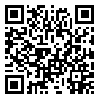Volume 10, Issue 1 (February 2023)
IJML 2023, 10(1): 75-82 |
Back to browse issues page
Department of Biochemistry, Faculty of Medicine, Iran University of Medical Sciences, Tehran, Iran
Abstract: (180 Views)
Background and Aims: The concomitant use of antioxidants during chemotherapy is controversial. It is unknown whether antioxidants increase or decrease the effectiveness of anticancer drugs. Therefore, the present study aimed to investigate ubiquinone's cytotoxic and antioxidant effects on the HepG2 cell line.
Materials and Methods: The HepG2 cell line was chosen as an experimental model for hepatocellular carcinoma in this study. The cytotoxic effect of ubiquinone was assessed as a function of time and concentration using the colorimetric MTT assay. The half-maximal inhibitory concentration (IC50) was determined to assess the cytotoxic effects of different ubiquinone concentrations. The protective impacts of ubiquinone on HepG2 cells were evaluated by assessing the oxidative stress profile.
Results: The MTT showed that the IC50 after treatment with ubiquinone was 350 and 335 μM at 24 and 48 hours, respectively. Evaluation of redox homeostasis in HepG2 cells using three doses of ubiquinone, including IC50 and one dose higher and one dose lower than IC50, showed a decrease in oxidative stress and an increase in the antioxidant capacity of HepG2 cells in a dose-dependent manner (p < 0.01). An increase in redox hemostasis decreased the viability of HepG2 cells.
Conclusion: Our results showed ubiquinone could reduce cancer cell survival by interfering in redox oxidative-redox status. Therefore, ubiquinone can be used as an antioxidant supplement along with chemotherapy drugs.
Materials and Methods: The HepG2 cell line was chosen as an experimental model for hepatocellular carcinoma in this study. The cytotoxic effect of ubiquinone was assessed as a function of time and concentration using the colorimetric MTT assay. The half-maximal inhibitory concentration (IC50) was determined to assess the cytotoxic effects of different ubiquinone concentrations. The protective impacts of ubiquinone on HepG2 cells were evaluated by assessing the oxidative stress profile.
Results: The MTT showed that the IC50 after treatment with ubiquinone was 350 and 335 μM at 24 and 48 hours, respectively. Evaluation of redox homeostasis in HepG2 cells using three doses of ubiquinone, including IC50 and one dose higher and one dose lower than IC50, showed a decrease in oxidative stress and an increase in the antioxidant capacity of HepG2 cells in a dose-dependent manner (p < 0.01). An increase in redox hemostasis decreased the viability of HepG2 cells.
Conclusion: Our results showed ubiquinone could reduce cancer cell survival by interfering in redox oxidative-redox status. Therefore, ubiquinone can be used as an antioxidant supplement along with chemotherapy drugs.
Type of Study: Research |
Subject:
Biochemistry
Received: 2022/11/20 | Accepted: 2023/01/28 | Published: 2023/03/1
Received: 2022/11/20 | Accepted: 2023/01/28 | Published: 2023/03/1
| Rights and permissions | |
 |
This work is licensed under a Creative Commons Attribution-NonCommercial 4.0 International License. |




